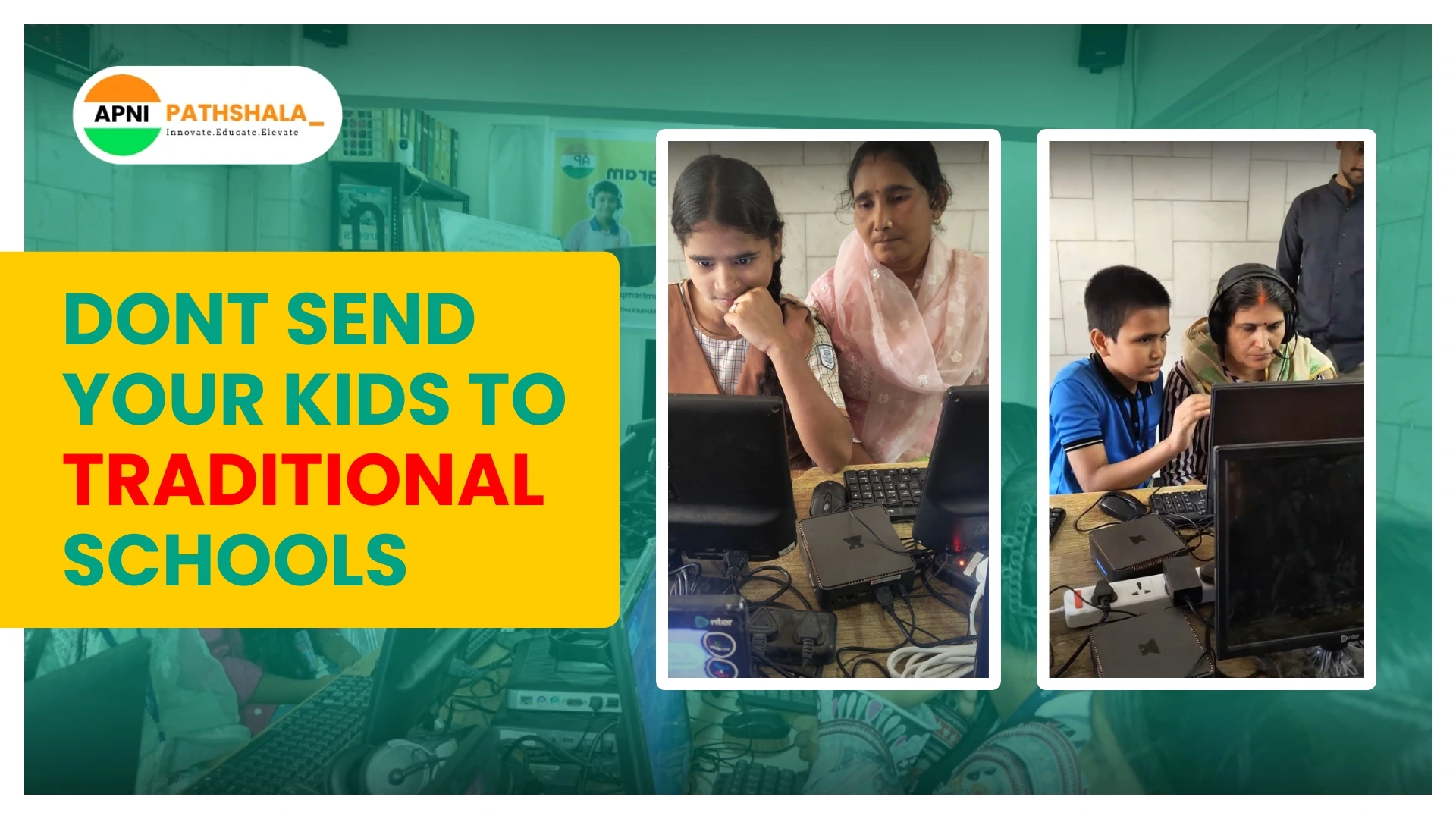Are you sure traditional schooling is the best for your child?
Let’s be honest. How many times have you seen your child come home from school looking exhausted, uninspired, and just… done? How often do they memorize things for exams, only to forget them the next day? How many of their days are spent following rigid schedules that leave zero room for creativity or actual learning?
If this feels relatable, you need to ask yourself—is traditional schooling really working for your child?
The truth is, most schools aren’t designed for real learning. They’re designed for control. They reward obedience, punish curiosity, and prioritize grades over actual understanding. But there’s a better way.
Why are traditional schools failing your child?
1. Schools Kill Creativity & Curiosity
Kids are born curious. They ask a million questions. They explore. They experiment. But what happens when they enter school? They’re told to sit down, be quiet, and follow instructions.
- Have you noticed how kids in preschool are curious and creative, but by the time they reach high school, they just want to get things over with?
- Schools reward the ability to memorize and repeat, not to think independently.
- They follow a generic template approach, forcing all kids to learn the same way, at the same speed, regardless of their interests or abilities.
2. The Education System Prepares Kids for a World That No Longer Exists
Let’s be real, schools were designed for the industrial era. They were meant to produce factory workers who followed orders. But today, we live in the age of AI, automation, and remote work. So why are we still relying solely on traditional school for our kids?
- Does school teach your child how to be financially independent? No.
- Does it teach them how to think critically and solve real-world problems? Nope.
- Instead, it’s focused on outdated textbooks, rote learning, and unnecessary stress.
3. Schools Are a Breeding Ground for Stress, Anxiety & Peer Pressure
Remember your own school days? The constant pressure to score well, fit in, and not make mistakes? Today, it’s even worse.
- Bullying and peer pressure take a toll on children’s mental health.
- Kids are constantly compared to their classmates, making them feel inadequate.
- The pressure of exams, competition, and never-ending homework destroys their love for learning.
And the worst part? Most parents see this happening but feel helpless to change it. But what if you had another option?
The Alternative: Real Learning Without Traditional School
We can’t just talk about the problem without giving you a solution. If traditional schools don’t work, then what’s the better alternative?
The answer lies in self-directed learning, homeschooling, microschools, and alternative education models that allow children to learn in a way that actually makes sense for them. At their own pace, based on their interests, and without the unnecessary stress of school.
1. Homeschooled Kids Learn Faster & Better
In traditional schools, students spend an average of 6–8 hours per day in classrooms. But have you ever thought about how much of that time is actually spent learning?
- We all know that only 20–30% of a school day is used for actual learning. The rest goes into passive listening, waiting for others to finish, unnecessary assignments, or just following rigid timetables.
- A homeschooled child, on the other hand, can complete the same academic learning in just 2–3 hours per day, and they understand it better.
Why do homeschooled kids learn faster?
- No time wasted on roll calls, forced discipline, or waiting for a large class to catch up.
- Personalized learning pace—if a child finds something easy, they move on; if it’s tough, they take their time.
- No generic approach—kids learn in a way that suits them best (visual, hands-on, reading, experimenting).
- More real-world learning—instead of just studying subjects, they apply them in real life.
Do homeschooled kids perform well academically?
Absolutely! Studies show that homeschooled students:
- Score actually higher on standardized tests compared to school students.
- Develop stronger problem-solving skills because they focus on understanding, not rote memorization.
- Have a higher success rate in college admissions because they build better portfolios.
2. They Develop Real-World Skills, Not Just Theories
Let’s be honest—how much of what we learned in school do we actually use in real life?
Schools spend years teaching trigonometry and Shakespeare, but ignore financial literacy, entrepreneurship, communication skills, and problem-solving.
Alternative education fixes this. Instead of just memorizing theory, kids learn practical skills they can use in the real world.
What kind of skills?
- Entrepreneurship: Running a small business, freelancing, or creating digital products.
- Coding & Tech Skills: Learning programming, AI, robotics, or app development at an early age.
- Finance & Money Management: Understanding savings, investments, and budgeting—things schools never teach.
- Creative Fields: Writing, filmmaking, music, digital art, photography—careers that actually interest them.
- Communication & Leadership: Developing public speaking, negotiation, and interpersonal skills.
Many teenagers today are self-taught programmers working on real-world projects while school kids are still stuck writing textbook answers.
Now, think about this—why should your child spend years studying things they’ll never use when they could be mastering the skills that will actually shape their future?
3. They Are Happier and Mentally Healthier
School is supposed to be about learning. But for many kids, it’s a source of stress, pressure, and anxiety.
- Overloaded curriculum: Kids are forced to study subjects they don’t care about just to pass exams.
- Toxic peer pressure: Constant comparisons, bullying, and unhealthy competition.
- Rigid rules: No space for creativity, self-expression, or curiosity.
- Exams = Self-worth: Instead of focusing on real learning, schools make kids believe their marks define their value.
What happens when kids escape this system?
- They learn without fear. No more studying just for exams—they learn for knowledge and growth.
- They explore their interests. They spend time doing what excites them, which naturally builds confidence.
- They have better mental health. No more stress about ranks, punishments, or meaningless competition.
Now, tell me—what’s more important? A report card filled with forced grades or a mentally strong, confident child ready to face the world?
How to Get Started With Alternative Education?
Thinking, “This sounds great, but how do I start?” Don’t worry, here’s a step-by-step guide.
Step 1: Explore Different Education Models
You don’t have to follow one rigid system. Choose what works best for your child.
- Homeschooling – Parents take full charge of their child’s education.
- Unschooling – Learning happens naturally through curiosity, experiences, and self-exploration.
- Micro Schools – Small learning communities where kids learn in flexible, personalized ways.
- Online Learning – Websites like BeyondExams provide structured playlists for self-directed learning.
Step 2: Find a Support System
- Join homeschooling communities to connect with experienced parents.
- Find mentors and alternative educators who can guide you.
- Build a personalized learning plan based on your child’s strengths.
Step 3: Use the Right Resources
- Online platforms offer courses that replace school.
- Books, podcasts, and real-world experiences help children learn better.
- Encourage hands-on learning through projects, field trips, and creative work.
Step 4: Start Small
- Begin with part-time homeschooling while your child is still in school.
- Gradually introduce alternative learning methods and observe what works.
- Make a smooth transition based on your child’s comfort and interest.
Final Thoughts: The Future of Learning is Here
As already mentioned above, traditional schools were designed for the industrial age, not for the future.
If you truly want your child to be prepared for the real world, then thinking beyond traditional schools is not just an option—it’s a necessity.
Start today. Explore alternative education. Give your child the learning experience they truly deserve.Want to explore self-directed learning?
Check out Apni Pathshala—India’s leading platform for homeschooling, unschooling, and alternative education.

